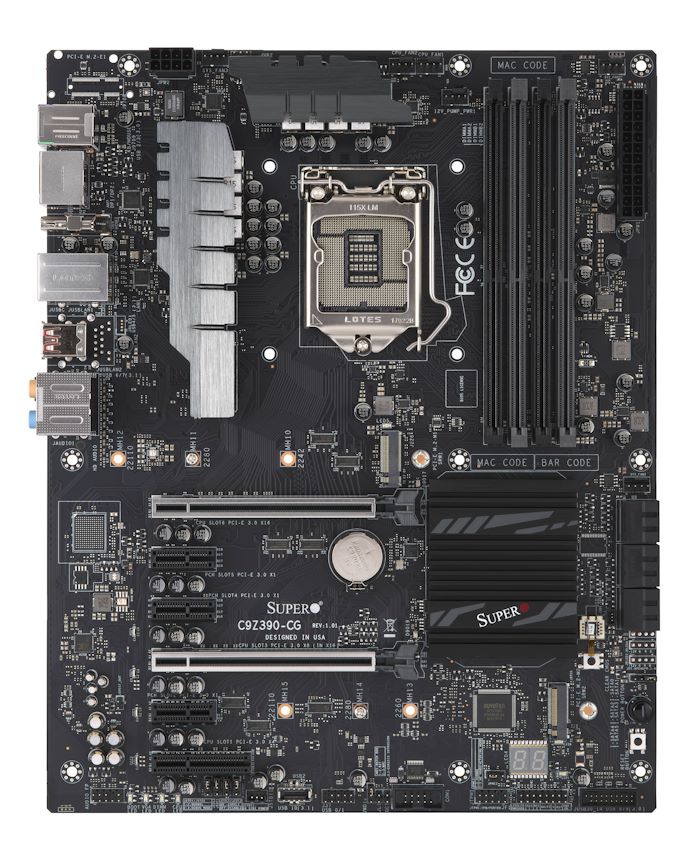Intel Z390 Motherboard Overview: 50+ Motherboards Analyzed
by Ian Cutress & Gavin Bonshor on October 8, 2018 10:53 AM EST- Posted in
- Motherboards
- Intel
- MSI
- Gigabyte
- ASRock
- EVGA
- Asus
- NZXT
- Supermicro
- Z390
Supermicro C9Z390-CG
The Supermicro C9Z390-CG and the more expensive C9Z390-CGW seemingly have the same PCB layout which could indicate that both PCB boards are identical in terms of specification, but with this model having less in the way of controllers etc. Aesthetically the CG drops the use of a rear panel cover with metallic grey power delivery heatsinks and a black/grey chipset heatsink. The other key difference is that the C9Z390-CG completely drops RGB support with no integrated LEDs or headers onboard at all. On the storage side of things, the C9Z390-CG has two PCIe 3.0 x4 M.2 slots and also includes a total of six SATA ports.
The C9Z390-CG has a total of four RAM slots with support for DDR4-3866 and up to 64 GB in total. On the PCIe front, the board has two full-length PCIe 3.0 slots which operate at ether x16/x4 with the bottom PCIe 3.0 x4 slot populated at the bottom and/or x16/x8 and the bottom slot is disabled when the second full-slot is in use. Separate to the these is a total of three PCIe 3.0 x1 slots.
Compared to the more feature-rich and more expensive C9Z390-CGW (on the previous page), the C9Z390-CG has the same layout minus one of the dual LAN and instead opts for a single Intel I219V Gigabit LAN. The USB ports included on the rear panel consist of three USB 3.1 Gen2 Type-A, one USB 3.1 Gen2 Type-C and two USB 3.0 Type-A ports. The onboard audio which consists of five 3.5 mm audio jacks and an optical S/PDIF output is controlled by a Realtek ALC1220 HD audio codec and the C9Z390-CG also has a trio of video outputs with two DisplayPort 1.2 and a single HDMI 1.4 port.
The Supermicro C9Z390-CG pricing as it stands is currently unavailable. The target market is gamers on a budget and offers a more cost-effective and solid feature set without passing the cost of flashy RGB and unnessacary visually pleasing covers with the primary focus being on the performance.












79 Comments
View All Comments
Smell This - Tuesday, October 9, 2018 - link
Much.Of.
The.
Same.
2 HSIO lanes per Gen 2 port and WiFi. Wow (rolling I-eyeballs) ...
MadAd - Tuesday, October 9, 2018 - link
58 motherboards, only 13 of which are smaller than ATX. When on earth are we going to move off this outdated oversized format? Its just more of the same every time, so depressing.gavbon - Wednesday, October 10, 2018 - link
13 is better than 0, or 12 :DMadAd - Wednesday, October 10, 2018 - link
Considering very small form formats (ITX) are harder to build for and only 7 are uATX, a size which is the most useful to transition away from ATX then no, it feels like an afterthought from a lazy industry. I mean who uses more than 1 main video card and 2-4 sticks of ram in a gaming PC these days? Even water builds into uATX isnt that hard to accomplish.After literally decades ATX should be a choice for edge cases not a mainstream build.
shaolin95 - Monday, October 22, 2018 - link
who cares about midge boards!Edkiefer - Wednesday, October 10, 2018 - link
All these MB with 2x 8 pin power inputs, is both mandatory and if so I guess new PSU will need 2x 8pin now.entity279 - Wednesday, October 10, 2018 - link
so it's ok to just buy SM motherboards now with them being involved in a security scandal?gavbon - Thursday, October 11, 2018 - link
I currently have the Supermicro C9Z390-PGW awaiting to go on the test bench next week, so from a consumers standpoint, I could potentially shed light on that board. As far as the Chinese/Supermicro/Spy scandal goes, I don't want to speculate without the finer details.eastcoast_pete - Wednesday, October 10, 2018 - link
Ian & Gavin, thanks for the overview.@ both - Question: I've read that Intel, to deal with its bad planning/capacity problems on 14 nm, has contracted the fabbing of some of its chipsets out to TSMC, specifically in TSMC's 22 nm tech. Is that correct, and did you have a chance to confirm that the new 390s used by these boards are indeed made by Intel on their 14 nm FinFET tech, or are they made by a contractor (TSMC)?
DanNeely - Wednesday, October 10, 2018 - link
AFAIK the chipsets being reverted to 22nm are using Intel's 22nm process in old unupgraded fabs. Doing so would be far less work than porting to a process from a different company; the latter would require massive rework to follow a completely different set of design rules.